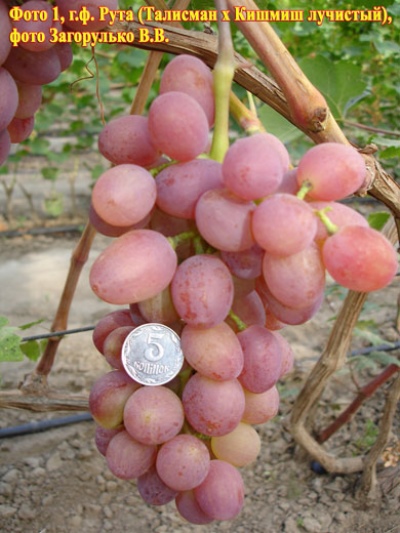
- Authors: Zagorulko Vitaly Vladimirovich
- Appointment: dining room
- Berry color: pink
- Taste: harmonious
- Ripening period: very early
- Ripening period, days: 95-100
- Frost resistance, ° C: -21
- Bunch weight, g: 400
- Flower type: functionally female
- Peeling: No
Many gardeners want to try to grow something new, exotic. As you know, not all varieties of any crops take root well on the territory of Russia. But the beautiful Ukrainian grape variety Ruta grows well in any part of Russia.
Breeding history
Table grape varieties are gaining unprecedented popularity among amateurs and gardeners, so breeders have to invent more and more interesting and unique varieties. The Ruta grape variety was bred by the Ukrainian breeder V. Zagorulko from the Zaporozhye region. In order to create a new species, he took two varieties as a basis, namely: Talisman grapes and Radiant raisins. The culture adopted all the worthy qualities of its predecessors, but Russian gardeners "tasted" this grape only by 2015.
Description
The Ruta grape has beautiful vigorous bushes. The vine is strong, reaching a length of 4 m. The plant does not have the ability to quickly spread its shoots, so frequent pruning is not necessary. The leaves are large, bright green in color, have 4-5 lobes.
The bunches are usually medium in size and the berries are large.
This crop can be planted around arches, as the bushes need additional support. Differs in a stable harvest and unpretentiousness to the soil. One of the advantages is the lack of friability and a long period of being on the bush without losing qualities or raisins.
Ripening period
The hybrid belongs to varieties with an early ripening period, the growing season is from 90 to 100 days. It turns out that the buds begin to swell in May, but the first harvest can already be removed in August.
Bunches
Ruta grapes have relatively small clusters. Their average weight is 400 g. The tassels are conical in shape, the stalks are strong, very short, of a greenish-brown hue.
Berries
The berries attract with their color, deep pink hue, with a raspberry or even amber sheen. The color depends on the amount of sunlight. The fruit is oval or nipple in shape. The skin is smooth, glossy, thin. The pulp is fleshy and juicy; when eaten, the berry crunches slightly. Bones are present.
On average, one berry weighs 12-14 g.
Taste
The berries have a pronounced sweet taste with a slight touch of nutmeg. There is a slight sour taste. The sugar content is 21%, but the acid is only 7 g.
Yield
The yield of the hybrid is average - 18 kg per bush. Fruiting is stable, albeit small.


Growing features
In order for the grapes to bear fruit well, a number of certain growing rules must be observed.
The variety does not like excessively moist soil. Therefore, it is worth watering only when the ground becomes dry.
It is necessary to loosen the soil at least once every two weeks.
It is worth leaving only 50-60 eyes, no more, otherwise the bushes will not cope.
Prune old branches.
Conduct disease prevention approximately 2 times in one season.
Landing
The method for planting is to choose a trench, this will have a beneficial effect on the growth of the vine. Trellises or arches should be installed along the trench. The distance between the seedlings should be 2-2.5 m, and the rows should be spaced from each other after 3 m.The depth of the pit should be 60 cm.Fertilizer (humus) is placed on the bottom, then a layer of soft earth, a seedling is planted, covered with earth and tamped ... After that, the earth is plentifully spilled with water and mulched as needed.

Pollination
Since the flowers of Ruta grapes are only female, gardeners plant nearby grapes with male flowers, most often it is Arcadia grapes.
Pruning
The first pruning is done in the spring. Bushes should be inspected for the presence of non-overwintered or dried branches. Next, the branches are examined for the presence of diseases. During flowering, it is necessary to remove weak shoots or those that began to grow in the wrong direction.
On average, one bush should have no more than 60 eyes. The grapes can overgrow, and this will interfere with pollination.
In the fall, the vines are cut for another 8-10 eyes.



Frost resistance and the need for shelter
The frost resistance of the culture is low, withstands up to -21 degrees. Without shelter, it will endure winter only in the southern regions. In the rest, covering material or spruce branches should be used for protection.

Diseases and pests
The brightly colored bunches are highly attractive to birds, so a fine mesh netting is best for protection. Wasps are indifferent to this culture, according to gardeners.
Other pests include leafworm, grape mite and phylloxera. For prevention, it is necessary to treat the vines with insecticides at least twice a season.

If a grape is exposed to any disease or insect, this always affects its appearance.
Storage
The variety can be stored in a dimly lit place for one month at a temperature not exceeding 5 degrees.











































































